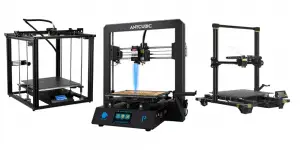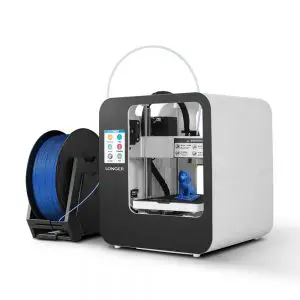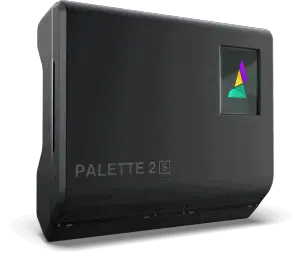One of the latest models to come from FlashForge is the Adventurer 3 3D printer. Right away, the performance users get for the price give it a competitive advantage over other 3D printers at a similar price point. It comes from a company establishing itself as a 3D printing industry leader.
Let’s take a look at FlashForge Adventurer 3 3D printer’s tech specs:
| Build Volume: | 150 mm x 150 mm x 150 mm |
| Build Speed: | Maximum 150 mm per second |
| Build Materials: | PLA, ABS, PEARL, PLA color Change, Metal, Wood, High-speed PLA |
| Filament Diameter: | 1.75 mm |
| Nozzle Diameter: | .40 mm |
| Extruder: | Single, removable |
| Connectivity: | USB, Wi-Fi, Ethernet, Cloud Printing |
| Software: | FlashPrint |
| Print Bed: | Heated, flexible, removable |
| Leveling: | Automatic |
| Display: | 2.8 inch touchscreen |
| Layer height: | .10 mm - .40 mm |
Design & Features
A FlashForge Adventurer 3 review isn’t complete without going over the features. As soon as the Adventurer 3 arrives, you notice its lightweight compact design. It’s fully enclosed, minus a gap on the side where the filament is fed through a hole to the nozzle. The nozzle is easily detached which allows for easy replacement and cleaning. FlashForge also offers an upgraded nozzle with a heating wire to maintain consistent temperature settings for the filament; it’s useful when printing with ABS and other exotic materials.
There is a spool holder compartment where filament can be held, but it’s designed for smaller rolls and it might be worth looking into printing or buying a stand to hold larger filaments as to not disrupt the build process. However, there is a filament sensor should you run out during a build and need to change rolls.
Users have access to a variety of alerts and settings from the 2.8-inch touchscreen that’s intuitive and easy to use. Navigating through the settings will show the automated leveling feature for the print be. It sits on a belt-like system but may need to be calibrated before printing since it’s marketed as being leveled at the factory. The bed is heated, removable, and flexible, making it easier to pop off builds once they are finished. Remember, the bed reaches 100°C so it will be extremely hot to the touch. Use caution when removing prints directly after they’ve finished.
With the FlashForge Adventurer 3 enclosed structure and ability to reach high temperatures in a controlled environment, users are free to experiment with a variety of filaments, and not bound to solely using FlashForge’s filaments. The nozzle heats up to 200°C in 50 seconds to get the machine going without much hassle. Let’s get into how the FlashForge Adventurer 3 3D printer prints.
Printing
As mentioned before, the filament is loaded in a compartment on the side of the Adventurer 3, which also houses the automated filament feeder. After choosing the build materials, files can be loaded from the company’s software, FlashPrint. Getting the files to the printer is easy enough with the ability to connect with the printer over Wi-Fi, through the included USB stick, an ethernet cable, or cloud printing. There are a few cloud services available design and store sliced files including TinkerCad.
Once the FlashForge Adventurer 3 is building the file, you’ll notice that it prints fairly quiet. FlashForge puts the printer at a soft 45-decibel noise level, making it optimal to run in classrooms, offices, studios, and labs without causing too much of a disruption.

One of the best features of printing with this FlashForge is the ability to toggle between print resolutions. Users can get layer heights as precise as .10 mm and printing at such a delicate layer height with reduced building speeds yields prints with exquisite detail. The nozzle and bed movement prints overhang on some models without the need of supports within the design file. Some enthusiasts have tried to use Cura as a slicer but the profiles don’t support the Adventurer, so be mindful when using non-proprietary slicers that there will be additional steps needed to convert the files for them to print correctly. FlashPrint is the recommended slicer and it’s compatible with Windows, MAC, and Linux operating systems.
There is minimum post-processing needed when printing at the highest resolution since it leaves very little imperfections, and layer lines are barely visible. Users do have the option to ramp up the speeds to a maximum of 150 mm per second, but beware the build is more likely to produce stringing and imperfections. Last, but not least, the build can be monitored from an app over Wi-Fi from a built-in 2-megapixel camera. This has to be one of the most exciting features of this 3D printer.
Packing & Assembly
The Adventurer 3 3D printer from FlashForge comes fully assembled and ready to go right out of the box. It’s truly a plug-and-play printer that users will find easy to power up and operate.
Here’s everything that comes with the package:
- 1 x FlashForge Adventurer 3 3D printer
- 1 x Quick start guide
- 1 x After sales service card
- 1 x Packet of grease
- 1 x Allen wrench
- 1 x Unclogging pin tool
- 1 x Screwdriver
- 1 x Power cable
- 1 x 250 g sample roll of PLA filament
Customer Support
When it comes to the warranty, FlashForge offers a standard manufacturer’s warranty that covers the printer for 180 days. There is an option to purchase an extended warranty through the company’s Pro Care programs with options to extend for 6 months or 12 months. For parts not covered, there are parts and accessories available to replace or enhance your FlashForge 3D printing experience with the Adventurer 3. Such as a pre-cut build plate print tape, filament guide tubes, nozzles, and even the build plate itself.
Should users run into any issues, there are options on the website to download the manual and updated versions of FlashPrint. There are videos on the website and across social media platforms to view tutorials about using the 3D printer, as well as, troubleshooting any issues. There’s an online community where users can find help too. Reaching out to FlashForge is an option too since the company makes itself available to customers through email.
FlashForge Adventurer 3 Pros & Cons
Pros
- filaments easier to do, and third party filaments are supported in this FlashForge model
- The touchscreen display is easy to use
- There’s a filament runout sensor coupled with a resume print feature allowing builds to pick up where it left off after changing filaments
- Multiple connectivity options include USB, Wi-Fi, ethernet, and cloud printing let the printer build files from just about anywhere
- The build plate is flexible, removable, and heated, but use caution when handling it
- Quiet printing lets the printer run in a number of settings
- Precision and high resolution builds are achievable with minimal layer heights
Cons
- The build plate can move around too much and cause the build to fail, and may need to be calibrated prior to printing
- Larger filament rolls can’t fit inside of the designated compartment
- Some users indicated a knocking noise from the filament feeder which may be attributed to using third party filaments
- The instruction manual can be confusing to get through
- The Wi-Fi connection may present some issues of updating the software
Verdict
The build area for the Adventurer 3 3D printer is a decent 5.9 inches cubed, fully enclosed, and able to reach high temperatures in a matter of seconds. While the cost is slightly higher than most budget-friendly 3D printers, the features and functionality make this printer worth consideration.
This FlashForge Adventurer 3 review finds this model’s performance enhances the 3D printing experience, especially when it’s backed by FlashForge’s community of users to reach out to for support. There’s also a vast amount of knowledge available on the website to guide Adventurer 3 users through common issues they may face.
Industries and hobbyists can find use for the Adventurer 3 3D printer when making architectural designs, toys, DIY projects, movie and cosplay props, and even household fixtures. The ease of use and multiple connectivity options allow users, from the novice to the experienced, to print designs within minutes of unboxing it. It prints quietly and quickly with precise detailing, making it ideal for offices, classrooms, and home use.
Last update on 2025-06-05 / Affiliate links / Images from Amazon Product Advertising API






